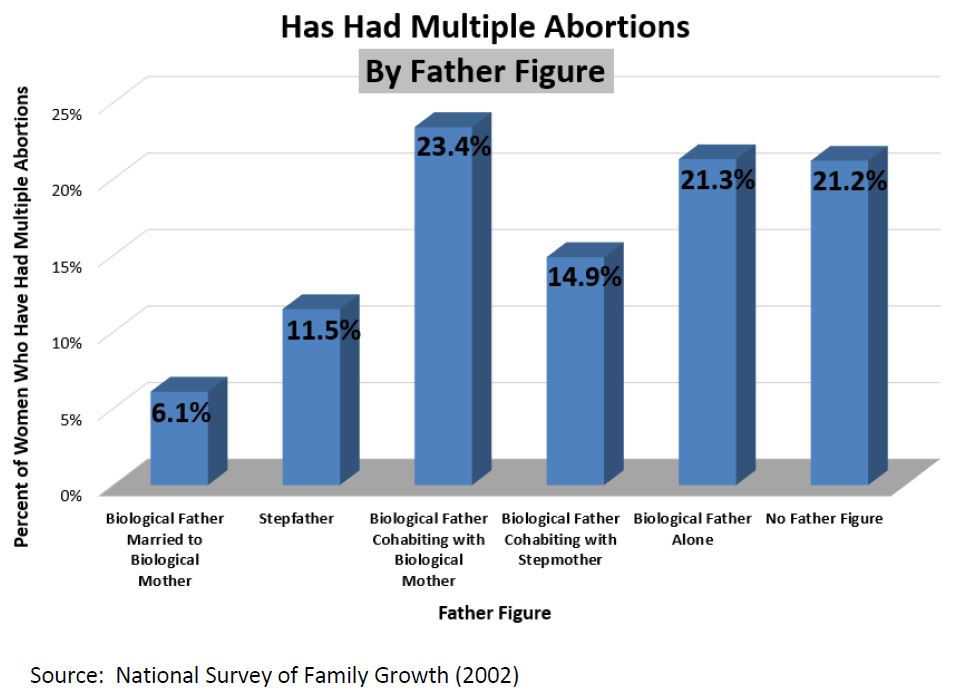Click Here to download “Has Had Multiple Abortions by Family Structure and Father Figure”
Has Had Multiple Abortions by Family Structure and Father Figure
The 2002 cycle of the National Survey of Family Growth showed that among women aged 38 to 44,[1] having had two or more abortions was least common among those raised in an intact family with two married biological parents. Family Structure: Fewer women raised in an intact married family had two or more abortions than those raised in a non-intact family. According to the National Survey of Family Growth, 45.7 percent of women raised in a cohabiting stepfamily had had two or more abortions, followed by those raised in an intact cohabiting family (23.4 percent), those raised in a married stepfamily (14.9 percent), those raised in an always-single parent family (8.5 percent), and those raised in a single-divorced parent family (7.8 percent). Women aged 38 to 44 who were raised in an intact married family were least likely to have had two or more abortions (6.0 percent). [2] Father Figure: Having had multiple abortions was least common among women raised by their biological father married to their biological mother (6.1 percent), and most common among women raised by their biological father cohabiting with their biological mother (23.4 percent). Around the same number of women raised by their biological father alone and with no father figure at all had had two or more abortions (21.3 percent and 21.2 percent, respectively).
Father Figure: Having had multiple abortions was least common among women raised by their biological father married to their biological mother (6.1 percent), and most common among women raised by their biological father cohabiting with their biological mother (23.4 percent). Around the same number of women raised by their biological father alone and with no father figure at all had had two or more abortions (21.3 percent and 21.2 percent, respectively).
 Related Insights from Other Studies: According to the National Center for Health Statistics, unmarried white women of childbearing age abort at a rate of just over 20 per thousand; unmarried Hispanic women do so at a rate of just under 40 per thousand, and unmarried black women at just over 60 per thousand. Married white women abort at a rate of around 5 per thousand, married Hispanic women abort at a rate of just under 10 per thousand, and married black women abort at a rate of around 15 per thousand.[3]
[1] NSFG only surveys women up to age 44. The oldest group of women was selected in order to capture the most complete range of outcomes for sexual experience.
[2] These charts draw on data collected by the National Survey of Family Growth, 2002
[3] Patrick Fagan, “Family and Social Trendlines 2014: The Behaviors of the American Family in the Five Major Institutions of Society,” (Washington, D.C.: Marriage and Religion Research Institute, 2014). Available at https://marri.us/publications/family-trends.]]>
Related Insights from Other Studies: According to the National Center for Health Statistics, unmarried white women of childbearing age abort at a rate of just over 20 per thousand; unmarried Hispanic women do so at a rate of just under 40 per thousand, and unmarried black women at just over 60 per thousand. Married white women abort at a rate of around 5 per thousand, married Hispanic women abort at a rate of just under 10 per thousand, and married black women abort at a rate of around 15 per thousand.[3]
[1] NSFG only surveys women up to age 44. The oldest group of women was selected in order to capture the most complete range of outcomes for sexual experience.
[2] These charts draw on data collected by the National Survey of Family Growth, 2002
[3] Patrick Fagan, “Family and Social Trendlines 2014: The Behaviors of the American Family in the Five Major Institutions of Society,” (Washington, D.C.: Marriage and Religion Research Institute, 2014). Available at https://marri.us/publications/family-trends.]]>
